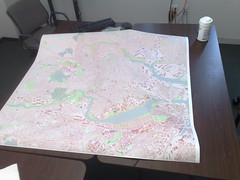Toronto Code Sprint: Day 2
Posted in Locality and Space, Mapserver, OSGeo, PostGIS, Toronto Code Sprint on March 8th, 2009 at 22:44:32Day 2 of the code sprint seemed to be much more productive. With much of the planning done yesterday, today groups were able to sit down and get to work.
Today, I accomplished two significant tasks:
- Setting up the new OSGeo Gallery, which is set to act as a repository for demos of OSGeo software users in the same way that the OpenLayers Gallery already does for OpenLayers. We’ve even added the first example.
- TMS Minidriver support for the GDAL WMS Driver: Sitting down and hacking out a way to access OSM tiles as a GDAL datasource, Schuyler and I built something which is reasonably simple/small — an 18k patch including examples and docs — but allows for a significant change in the ability to read tiles from existing tileset datasources on the web.
Other things happening at the sprint today were more WKT Raster discussions, liblas hacking, and single-pass MapServer discussions, as well as some profiling of MapServer performance with help from Paul and Shark. Thanks to the participation of the LizardTech folks, I think there will also be some performance testing done with MrSID rendering within MapServer, and there was — as always — more discussion of the “proj strings are expensive to look up!” discussion.
Other than that, it was a quiet day; lots of work getting done, but not much excitement in the ranks.
We then had a great dinner at Baton Rouge, and made it home.
This evening, I’ve been doing a bit more hacking, opening a GDAL Trac ticket for an issue Schuyler bumped into with the sqlite driver, and pondering the plan for OpenLayers tomorrow.
As before, a special thanks to the conference sponsors for today: Coordinate Solutions via David Lowther, and the lovely folks at SJ Geophysics Ltd.. Thanks for helping make this thing happen! I can guarantee that neither of those GDAL tickets would have happened without this time.
